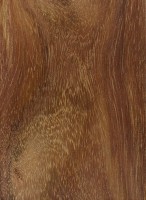 |
Common Name(s): Sissoo, Sheesham Scientific Name: Dalbergia sissoo Distribution: Primarily northern India, Nepal, and Tree Size: 35-65 ft (10-20 m) tall, 2-3 ft (.6-1 m) trunk diameter Average Dried Weight: 48 lbs/ft3 (770 kg/m3) Specific Gravity (Basic, 12% MC): .63, .77 Janka Hardness: 1,660 lbf (7,380 N) Modulus of Rupture: 14,140 lbf/in2 (97.5 MPa) Elastic Modulus: 1,508,000lbf/in2 (10.40 GPa) Crushing Strength: 8,050 lbf/in2 (55.5 MPa) Shrinkage: Radial: 3.1%, Tangential: 5.3%, Volumetric: 8.4%, T/R Ratio: 1.8 |
Color/Appearance: Heartwood ranges from golden brown to a darker reddish brown. The pale, straw-colored sapwood is clearly demarcated from the heartwood, and is sometimes incorporated into finished products—possibly for reasons of economy rather than aesthetics.
Grain/Texture: Sissoo generally has a straight grain, though it can be interlocked—sometimes severely so. Texture is medium to coarse with a good natural luster.
Endgrain: Diffuse-porous; large to very large pores in no specific arrangement, few to very few; solitary and radial multiples of 2-3; gums and other heartwood deposits (reddish brown) common; narrow rays not visible without lens, normal to fairly close spacing; parenchyma vasicentric, winged, and confluent.
Rot Resistance: Sissoo has good decay resistance and is rated as durable to very durable.
Workability: Sissoo has good working characteristics, and responds well to nearly all machining operations (the exception being sections of wood with interlocked grain, which tend to tear out during surfacing). However, chalky deposits occasionally present in the wood can dull cutters quickly. Sissoo turns, glues, and finishes well.
Odor: Sissoo has a distinct scent that is characteristic of most rosewoods in the Dalbergia genus, though the scent is somewhat milder than other species.
Allergies/Toxicity: Although Sissoo is usually considered to be less allergenic than other rosewoods in the Dalbergia genus, it has still been reported to cause skin irritation. See the articles Wood Allergies and Toxicity and Wood Dust Safety for more information.
Pricing/Availability: Almost never exported to the United States, Sissoo is highly valued in India, where its price is on par with Teak. The tree itself tends to grow in a crooked fashion, so long, clear sections of lumber are seldom seen. One of the few Dalbergia species where certified sources are available.
Sustainability: Although Sissoo is not evaluated on the IUCN Red List of Threatened Species, it is listed on CITES appendix II under the genus-wide restriction on all Dalbergia species—which also includes finished products made of the wood.
Common Uses: Veneer, plywood, musical instruments (percussion), furniture, flooring, boatbuilding, carving, and turned objects.
Comments: Sissoo is sometimes called “Indian Rosewood,” and though it is a member of the Dalbergia genus, its status as an official rosewood is disputed. It’s density, hardness, and color intensity are lower than other rosewoods, but the wood is held in high regard in its native India, where it is a very valuable timber.
- African Blackwood (Dalbergia melanoxylon)
- Amazon Rosewood (Dalbergia spruceana)
- Bois de Rose (Dalbergia maritima)
- Brazilian Rosewood (Dalbergia nigra)
- Burmese Blackwood (Dalbergia cultrata)
- Burmese Rosewood (Dalbergia oliveri)
- Cocobolo (Dalbergia retusa)
- East Indian Rosewood (Dalbergia latifolia)
- Brazilian Rosewood (Dalbergia nigra)
- Honduran Rosewood (Dalbergia stevensonii)
- Kingwood (Dalbergia cearensis)
- Madagascar Rosewood (Dalbergia baronii)
- Siamese Rosewood (Dalbergia cochinchinensis)
- Tulipwood (Dalbergia decipularis)
- Yucatan Rosewood (Dalbergia tucurensis)
Scans/Pictures: A special thanks to Jonathan Bluestein for providing the turned photo of this wood species.


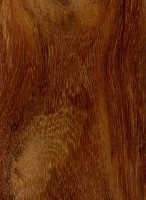
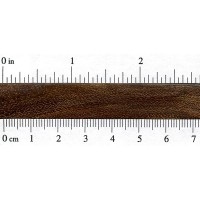
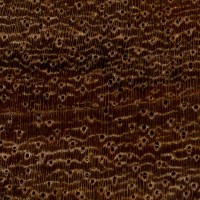
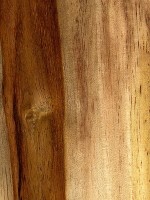
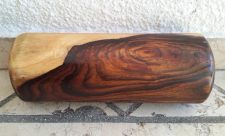



I have a table made out of sissoo that is a mix of sapwood and heartwood so it has a lot of contrast. I am struggling to find the right stain product (oil, water, gel) and color to complement the heartwood and even out the contrast of the sapwood. Any ideas?
Send picture please and I will try to help
A jewellery box for my dautgher (12 years)
My single slab desk made of Sisso from Florida.
Is this sissoo with sapwood?
Yes, for sure.
Would appreciate if anyone can help to confirm/identify the tree from the photo below. I think it is Sisso, but really not sure. I took these tree stumps when our local council was cutting down a tree on the street. We live in UK. Thanks.
Sisso does not grow in the uk, this is most definitely not sisso and appears to be beech.
Given the bark pattern and the dark lines, I think this is spalted beech. It is widely spread in the UK as well as Ireland. Sisso is native to India and Pakistan. This is how sisso logs look, which are appearantly different in terms of end grains and bark patterns.
I was gifted Rosewood bowls but am uncertain if they can be used for salads.
Any suggestions or data on this topic are appreciated.
Yes it can be used
Miniature table made of Sissoo, by Ofer Ovadia (Israel). Finished with flaxseed oil and beewax.
Items I made from Dalbergia Sissoo branches – an ashtray and a business card holder.
I gathered a few thick branches that were sewn-off a Dalbergia sissoo today, in my native country of Israel. Here it grows quite abundantly in cities, where it is frequently planted for decorative purposes. The picture below is of a dried-off section where a branch was cut, likely several years ago. Therefore, the wood at that small section is dry, while most of the other wood was fresh. Being dry, it shows the final grain pattern. The grain is slightly popped out by the polyurethane I used to seal the branch cutting for overall drying.
“Dalbergia sissoo”(Indian Rosewood) is primarily used for furniture in northern India. Its export is highly regulated due to recent high rates of death due to unknown causes.Dalbergia sissoo, which has historically been the primary rosewood species of northern India.This wood is strong and tough. It is extreme durable and handsome and it maintains its shape well. It can be easily seasoned. It is difficult to work but it takes a fine polish. It is used for high quality furniture, plywoods, bridge piles, sport goods, railway sleepers and so forth. It is a very good material for decorative works and carvings.… Read more »
Dalbergia sissoo is True Rosewood and also proved under research organisation
No properties are listed for this species, yet it is available as a landscape tree in the North American Southwest. Does it have similar properties to the other Dalbergias such that it might serve as a substitute for the rare and protected species?
Dalbergia sisoo is now a category II invasive species in FL, and as nursery companies promoted it in AZ, rapidly becoming an invasive problem there as well. In an area with, or even NEAR lawn irrigation, it spreads fast andnsuckers EVERYWHERE.
People on poor advicenfrom plant suppliers will plant these in suburban lawns, then these trees eat their yard alive. The surtace roots smash foundations and paved areas, break water lines, knock over masonry walls and generally wreck annything requiring stable ground.
Lift the CITES ban for this wood (exported from North America only) and let the extinction begin.
Dalbergia sisoo is excellent as firewood if dried properly. The smaller trees can be cleared and repurposed for heating.
Sissoo has also (here in AZ) become an abundant source of woodturning blanks as everyone begins to tear them out once they crack the foundations of walls and homes, sidewalks and roads.